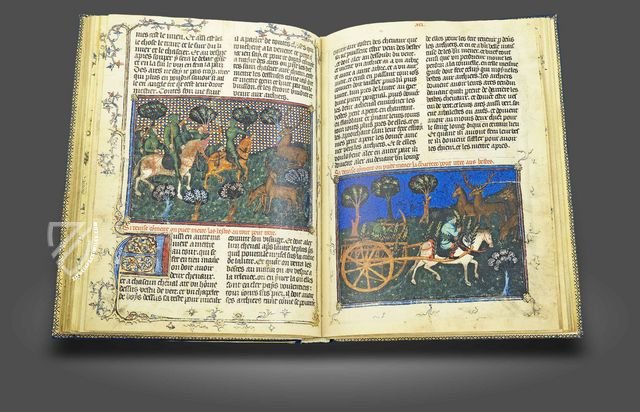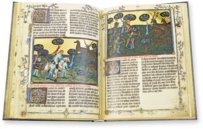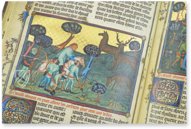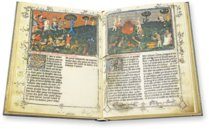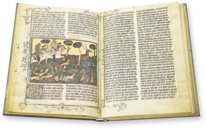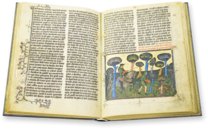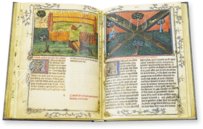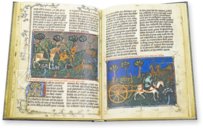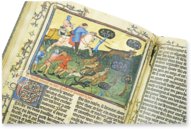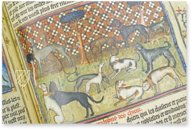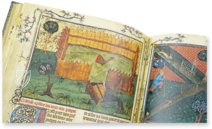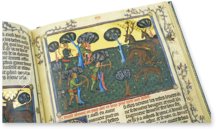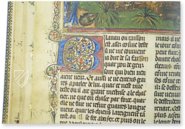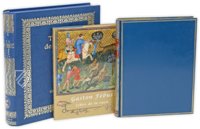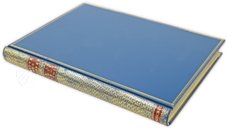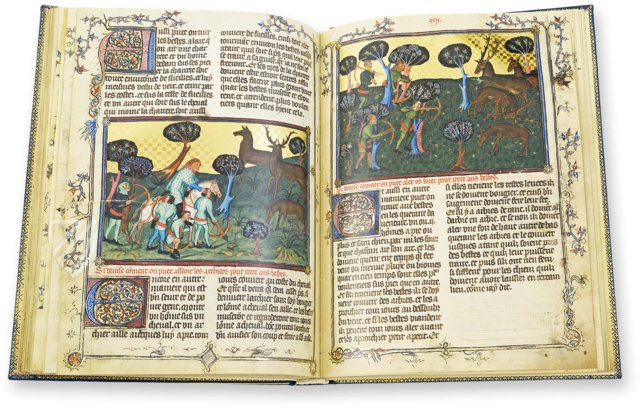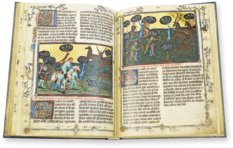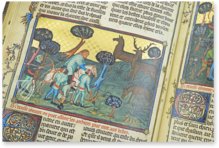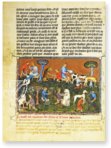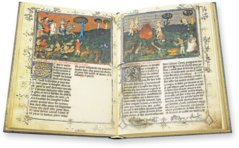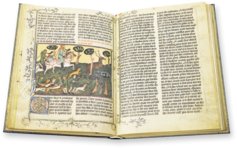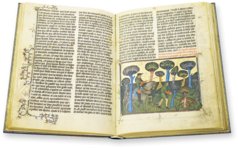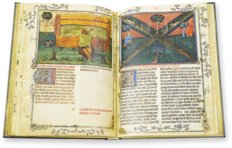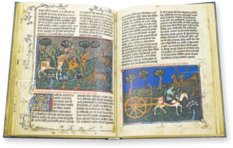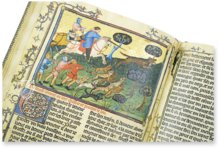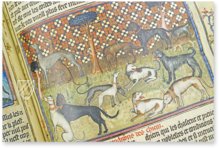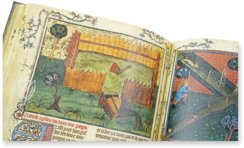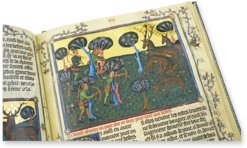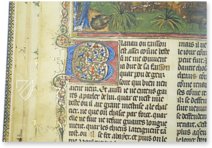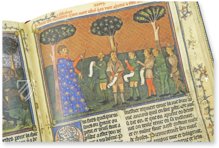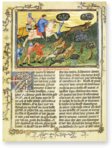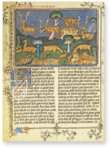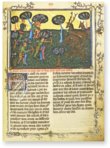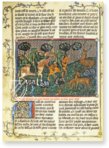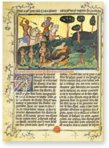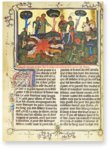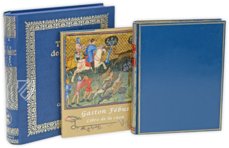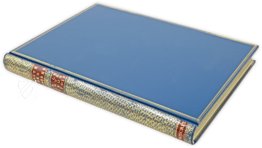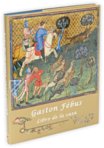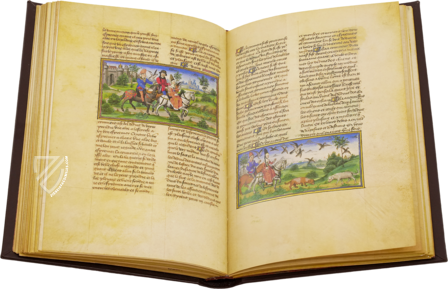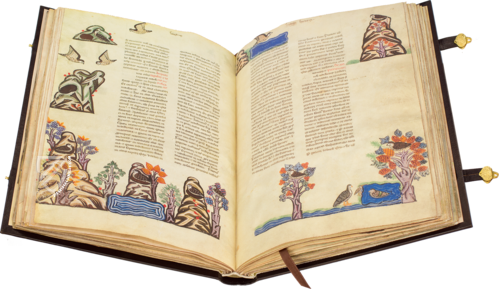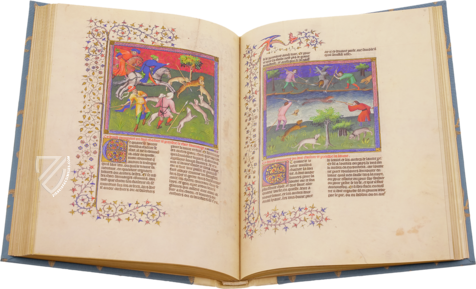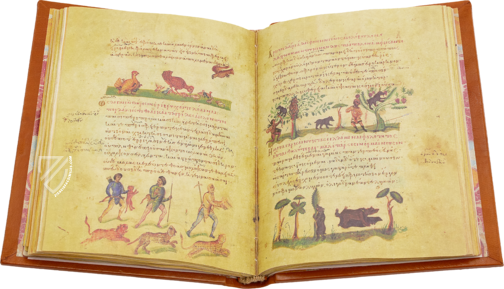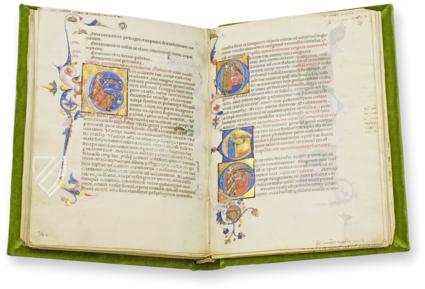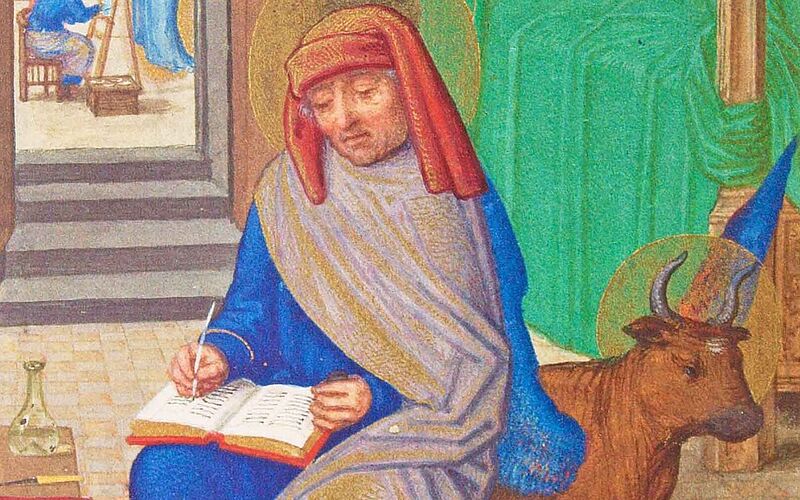Book of Hunting of Gaston III Phoebus
(3,000€ - 7,000€)
Gaston III, Count of Foix and also known by the epithet Phoebus, composed a work in the 14th century that made him unforgettable: the famous Livre de la chasse, the Book of Hunting. Dedicated to Philip the Bold, this treatise deals with courtly hunting and presents itself as a comprehensive textbook on the subject. It describes, for example, natural scientific and biological information about huntable wildlife and how to track them down, and gives instructions on the successful training, medical care, and grooming of hounds. In the Hermitage in St. Petersburg is kept a particularly beautifully illuminated manuscript of this Book of Hunting by Gaston Phoebus. Created in France towards the end of the 14th century, this masterpiece of Gothic book art delights with splendid, gold-adorned miniatures in elegant frames and large, artistic initials with scroll ornament. In this way, it also offers a unique insight into the late 14th century aristocratic society!
Book of Hunting of Gaston III Phoebus
Gaston II, Count of Foix and also known by the epithet Phoebus, composed a work in the 14th century that made him unforgettable: the famous Livre de la chasse, the Book of Hunting. Dedicated to Philip the Bold, it is concerned with the theme of courtly hunting and presents itself as a comprehensive textbook on the subject. A particularly beautiful illuminated manuscript of this Book of Hunting by Gaston III is stored in St. Petersburg. Originating from France at the end of the 14th century, this masterpiece of illumination amazes with magnificent miniatures in elegant frames. In this way, it offers a unique glimpse into the late 14th century!
The Hunt in the Middle Ages
A pack of hunting dogs dash through the forest, followed by lordly riders on noble steeds. A wild boar flounders in the hunter’s nets, and a bird of prey is prepared to help with the hunting of rabbits. All of these wonderful scenes play out in the illustrations of the Livre de la chasse by Gaston III also known as Gaston Phoebus. Gaston III (1331–1391), the Count of Foix, was the author of this famous French treatise on hunting. He composed an exciting textbook of medieval hunting between the years 1387–1389. The hunt was a privilege of the rulers and noblemen for a long time and was presented in all its facets in the Book of Hunting.
A Noteworthy Edition
The Livre de la chasse by Gaston III survives in several manuscripts, some of them illustrated. These are found in the Parisian Bibliothèque Nationale and the Morgan Library in New York, inter alia. A particularly beautiful specimen can be found in the Hermitage in St. Petersburg. Manuscript OP N.º 2 of their manuscript collection arose in France at the end of the 14th century, and thus shortly after the creation of the text its self. The treatise on hunting, spanning 224 pages with an impressive format of 33 x 23 cm, is illustrated with 78 full-page miniatures.
A Marvelous Image of the 14th Century
A half-page miniature above or below the text accompanies each of the explanations about hunting. These scenes were surrounded by fine, ornamental frames. Delicate floral bordures and precious gold initials round out the splendid overall impression of the manuscript. The depictions present all aspects of the theme, which are addressed in the famous treatise. Gaston III’s textbook, which was dedicated to Philip the Bold, contains natural scientific and biological information about wild game and gives some directions for the specific training of hunting dogs. In combination with its wonderful miniatures, the St. Petersburg manuscript of the Livre de la chasse – one of the most beautiful examples of this tradition of hunting books – offers a magnificent glimpse into the 14th century!
Codicology
- Alternative Titles
- Libro de la Caza de Gastón III
Livre de la Chasse
Buch der Jagd - Size / Format
- 224 pages / 33.0 × 23.0 cm
- Origin
- France
- Date
- End of the 14th century
- Epochs
- Style
- Genre
- Language
- Script
- Gothic
- Illustrations
- 78 half-page miniatures, all pages with floral bordures, numerous large initials in red, blue, and gold
- Content
- Treatise on hunting
- Artist / School
- Gaston III, Lord of Foix and Bearn (1331–1391) (author)
Book of Hunting of Gaston III Phoebus
Caring for Hunting Dogs
The medieval hunt required different kinds of four-legged helpers who are the modern predecessors of breeds including greyhounds, bloodhounds, and mastiffs. Not only used to find and flush game, hunting dogs also fought dangerous game like boar and bear alongside their human partners. Various huntsmen are shown maintaining their master’s dogs before a diamond-patterned background of red and gold: claws are being filed, rotten teeth are being pulled, and injured legs are being bandaged.
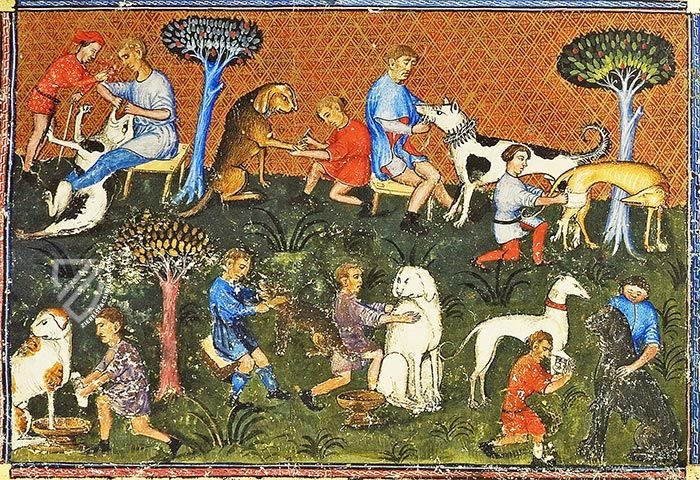
Book of Hunting of Gaston III Phoebus
Hunting a Wolf
The war between man and wolf was the great unsung struggle of the Middle Ages. Europe was covered by forests and packs of wolves presented a serious threat not only to farmers’ flocks but to the members of the community – especially children. Framed by elegant tendrils and accompanied by a splendid “C” initial, this miniature is presented before an elegant, checkered gold leaf background.
The dynamic scene shows the wolf in mid-stride as a nobleman on horseback and armed with a sword pursues alongside a pack of hounds while a huntsman on foot stops to throw a spear at the fleeing beast. Furthermore, the artist has included numerous details from the clothing to the equipment, such as the hunting horns worn by the two men on horseback.
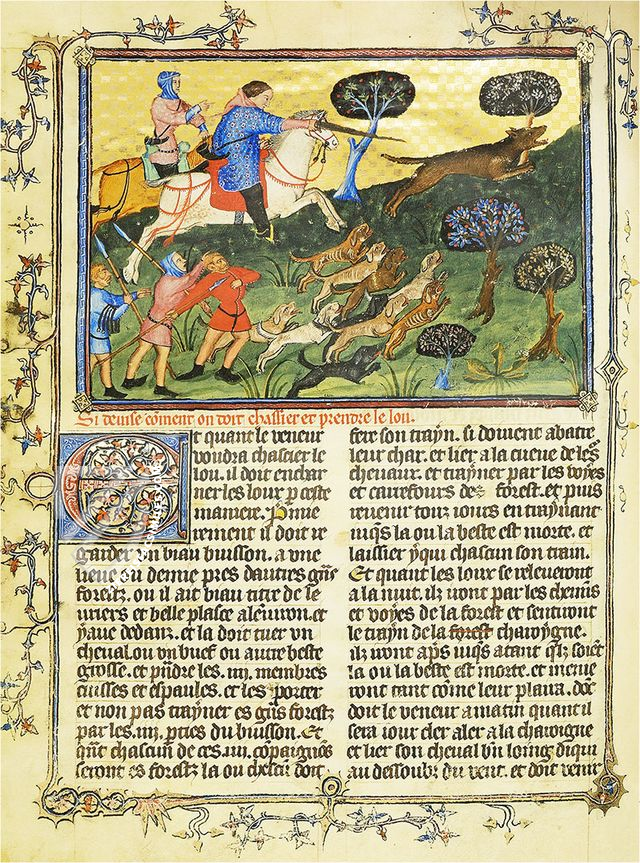
#1 Libro de la Caza de Gastón III
Language: Spanish
(3,000€ - 7,000€)
- Treatises / Secular Books
- Apocalypses / Beatus
- Astronomy / Astrology
- Bestiaries
- Bibles / Gospels
- Chronicles / History / Law
- Geography / Maps
- Saints' Lives
- Islam / Oriental
- Judaism / Hebrew
- Single Leaf Collections
- Leonardo da Vinci
- Literature / Poetry
- Liturgical Manuscripts
- Medicine / Botany / Alchemy
- Music
- Mythology / Prophecies
- Psalters
- Other Religious Books
- Games / Hunting
- Private Devotion Books
- Other Genres
- Afghanistan
- Armenia
- Austria
- Belgium
- Belize
- Bosnia and Herzegovina
- China
- Colombia
- Costa Rica
- Croatia
- Cyprus
- Czech Republic
- Denmark
- Egypt
- El Salvador
- Ethiopia
- France
- Germany
- Greece
- Guatemala
- Honduras
- Hungary
- India
- Iran
- Iraq
- Israel
- Italy
- Japan
- Jordan
- Kazakhstan
- Kyrgyzstan
- Lebanon
- Liechtenstein
- Luxembourg
- Mexico
- Morocco
- Netherlands
- Palestine
- Panama
- Peru
- Poland
- Portugal
- Romania
- Russia
- Serbia
- Spain
- Sri Lanka
- Sweden
- Switzerland
- Syria
- Tajikistan
- Turkey
- Turkmenistan
- Ukraine
- United Kingdom
- United States
- Uzbekistan
- Vatican City
- A. Oosthoek, van Holkema & Warendorf
- Aboca Museum
- Ajuntament de Valencia
- Akademie Verlag
- Akademische Druck- u. Verlagsanstalt (ADEVA)
- Aldo Ausilio Editore - Bottega d’Erasmo
- Alecto Historical Editions
- Alkuin Verlag
- Almqvist & Wiksell
- Amilcare Pizzi
- Andreas & Andreas Verlagsbuchhandlung
- Archa 90
- Archiv Verlag
- Archivi Edizioni
- Arnold Verlag
- ARS
- Ars Magna
- ArtCodex
- AyN Ediciones
- Azimuth Editions
- Badenia Verlag
- Bärenreiter-Verlag
- Belser Verlag
- Belser Verlag / WK Wertkontor
- Benziger Verlag
- Bernardinum Wydawnictwo
- BiblioGemma
- Biblioteca Apostolica Vaticana (Vaticanstadt, Vaticanstadt)
- Bibliotheca Palatina Faksimile Verlag
- Bibliotheca Rara
- Boydell & Brewer
- Bramante Edizioni
- Bredius Genootschap
- Brepols Publishers
- British Library
- C. Weckesser
- Caixa Catalunya
- Canesi
- CAPSA, Ars Scriptoria
- Caratzas Brothers, Publishers
- Carus Verlag
- Casamassima Libri
- Centrum Cartographie Verlag GmbH
- Chavane Verlag
- Christian Brandstätter Verlag
- Circulo Cientifico
- Club Bibliófilo Versol
- Club du Livre
- CM Editores
- Collegium Graphicum
- Collezione Apocrifa Da Vinci
- Comissão Nacional para as Comemorações dos Descobrimentos Portugueses
- Coron Verlag
- Corvina
- CTHS
- D. S. Brewer
- Damon
- De Agostini/UTET
- De Nederlandsche Boekhandel
- De Schutter
- Deuschle & Stemmle
- Deutscher Verlag für Kunstwissenschaft
- DIAMM
- Droz
- E. Schreiber Graphische Kunstanstalten
- Ediciones Boreal
- Ediciones Grial
- Ediclube
- Edições Inapa
- Edilan
- Editalia
- Edition Deuschle
- Edition Georg Popp
- Edition Leipzig
- Edition Libri Illustri
- Editiones Reales Sitios S. L.
- Éditions de l'Oiseau Lyre
- Editions Medicina Rara
- Editorial Casariego
- Editorial Mintzoa
- Editrice Antenore
- Editrice Velar
- Edizioni Edison
- Egeria, S.L.
- Eikon Editores
- Electa
- Emery Walker Limited
- Enciclopèdia Catalana
- Eos-Verlag
- Ephesus Publishing
- Ernst Battenberg
- Eugrammia Press
- Extraordinary Editions
- Fackelverlag
- Facsimila Art & Edition
- Facsimile Editions Ltd.
- Facsimilia Art & Edition Ebert KG
- Faksimile Verlag
- Feuermann Verlag
- Folger Shakespeare Library
- Franco Cosimo Panini Editore
- Friedrich Wittig Verlag
- Fundación Hullera Vasco-Leonesa
- G. Braziller
- Gabriele Mazzotta Editore
- Gebr. Mann Verlag
- Gesellschaft für graphische Industrie
- Getty Research Institute
- Giovanni Domenico de Rossi
- Giunti Editore
- Graffiti
- Grafica European Center of Fine Arts
- Guido Pressler
- Guillermo Blazquez
- Gustav Kiepenheuer
- H. N. Abrams
- Harrassowitz
- Harvard University Press
- Helikon
- Hendrickson Publishers
- Henning Oppermann
- Herder Verlag
- Hes & De Graaf Publishers
- Hoepli
- Holbein-Verlag
- Houghton Library
- Hugo Schmidt Verlag
- Idion Verlag
- Il Bulino, edizioni d'arte
- ILte
- Imago
- Insel Verlag
- Insel-Verlag Anton Kippenberger
- Instituto de Estudios Altoaragoneses
- Instituto Nacional de Antropología e Historia
- Introligatornia Budnik Jerzy
- Istituto dell'Enciclopedia Italiana - Treccani
- Istituto Ellenico di Studi Bizantini e Postbizantini
- Istituto Geografico De Agostini
- Istituto Poligrafico e Zecca dello Stato
- Italarte Art Establishments
- Jan Thorbecke Verlag
- Johnson Reprint Corporation
- Josef Stocker
- Josef Stocker-Schmid
- Jugoslavija
- Karl W. Hiersemann
- Kasper Straube
- Kaydeda Ediciones
- Kindler Verlag / Coron Verlag
- Kodansha International Ltd.
- Konrad Kölbl Verlag
- Kurt Wolff Verlag
- La Liberia dello Stato
- La Linea Editrice
- La Meta Editore
- Lambert Schneider
- Landeskreditbank Baden-Württemberg
- Leo S. Olschki
- Les Incunables
- Liber Artis
- Library of Congress
- Libreria Musicale Italiana
- Lichtdruck
- Lito Immagine Editore
- Lumen Artis
- Lund Humphries
- M. Moleiro Editor
- Maison des Sciences de l'homme et de la société de Poitiers
- Manuscriptum
- Martinus Nijhoff
- Maruzen-Yushodo Co. Ltd.
- MASA
- Massada Publishers
- McGraw-Hill
- Metropolitan Museum of Art
- Militos
- Millennium Liber
- Müller & Schindler
- Nahar - Stavit
- Nahar and Steimatzky
- National Library of Wales
- Neri Pozza
- Nova Charta
- Oceanum Verlag
- Odeon
- Orbis Mediaevalis
- Orbis Pictus
- Österreichische Staatsdruckerei
- Oxford University Press
- Pageant Books
- Parzellers Buchverlag
- Patrimonio Ediciones
- Pattloch Verlag
- PIAF
- Pieper Verlag
- Plon-Nourrit et cie
- Poligrafiche Bolis
- Presses Universitaires de Strasbourg
- Prestel Verlag
- Princeton University Press
- Prisma Verlag
- Priuli & Verlucca, editori
- Pro Sport Verlag
- Propyläen Verlag
- Pytheas Books
- Quaternio Verlag Luzern
- Reales Sitios
- Recht-Verlag
- Reichert Verlag
- Reichsdruckerei
- Reprint Verlag
- Riehn & Reusch
- Roberto Vattori Editore
- Rosenkilde and Bagger
- Roxburghe Club
- Salerno Editrice
- Saltellus Press
- Sandoz
- Sarajevo Svjetlost
- Schöck ArtPrint Kft.
- Schulsinger Brothers
- Scolar Press
- Scrinium
- Scripta Maneant
- Scriptorium
- Shazar
- Siloé, arte y bibliofilia
- SISMEL - Edizioni del Galluzzo
- Sociedad Mexicana de Antropología
- Société des Bibliophiles & Iconophiles de Belgique
- Soncin Publishing
- Sorli Ediciones
- Stainer and Bell
- Studer
- Styria Verlag
- Sumptibus Pragopress
- Szegedi Tudomànyegyetem
- Taberna Libraria
- Tarshish Books
- Taschen
- Tempus Libri
- Testimonio Compañía Editorial
- Thames and Hudson
- The Clear Vue Publishing Partnership Limited
- The Facsimile Codex
- The Folio Society
- The Marquess of Normanby
- The Richard III and Yorkist History Trust
- Tip.Le.Co
- TouchArt
- TREC Publishing House
- TRI Publishing Co.
- Trident Editore
- Tuliba Collection
- Typis Regiae Officinae Polygraphicae
- Union Verlag Berlin
- Universidad de Granada
- University of California Press
- University of Chicago Press
- Urs Graf
- Vallecchi
- Van Wijnen
- VCH, Acta Humaniora
- VDI Verlag
- VEB Deutscher Verlag für Musik
- Verlag Anton Pustet / Andreas Verlag
- Verlag Bibliophile Drucke Josef Stocker
- Verlag der Münchner Drucke
- Verlag für Regionalgeschichte
- Verlag Styria
- Vicent Garcia Editores
- W. Turnowski Ltd.
- W. Turnowsky
- Waanders Printers
- Wiener Mechitharisten-Congregation (Wien, Österreich)
- Wissenschaftliche Buchgesellschaft
- Wissenschaftliche Verlagsgesellschaft
- Wydawnictwo Dolnoslaskie
- Xuntanza Editorial
- Zakład Narodowy
- Zollikofer AG

